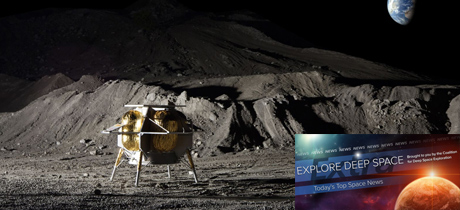In Today’s Deep Space Extra… NASA Tuesday called on more commercial companies to submit proposals for its Commercial Lunar Payload Services initiative and announced agreements with 13 companies to develop technologies on seven fronts for Moon and Mars exploration. Russia plans a fast track cargo mission to the International Space Station (ISS) on Wednesday.
Human Space Exploration
NASA warns commercial crew delays create uncertainty in ISS operations
Coalition Member in the News – Boeing
SpaceNews.com (7/30): Uncertainty over how soon NASA and its Commercial Crew Program partners, Boeing and SpaceX, can complete test flight activities to achieve certification of their new vehicles to transport astronauts to and from the International Space Station (ISS) appear likely to disrupt the pace of research activities and maintenance aboard the orbiting science lab, a top agency executive told the ISS Research and Development Conference on Tuesday.
NASA announces U.S. industry partnerships to advance Moon, Mars technology
Coalition Members in the News – Aerojet Rocketdyne, Lockheed Martin
NASA (7/30): NASA on Tuesday announced the selections of 13 companies, startups as well as aerospace vets headquartered across the U.S., to address specific technology requirements for advancing human exploration into deep space and U.S. leadership in the field on seven technology fronts. Each will work with one or more NASA field centers under Space Act Agreements.
Soyuz booster rolls out to launch pad with Space Station refueling freighter
Spaceflightnow.com (7/29): Russia for a third time has prepared for a fast track Progress cargo delivery mission to the six person International Space Station (ISS). The Progress MS-12 freighter is set to launch from the Baikonur Cosmodrome in Kazakhstan on Wednesday at 8:10 a.m., EDT, with a more than 5,000 pound payload that includes crew supplies, science gear and propellant. Russia will strive for a two orbit, 3 1/2 hour sprint. Docking is scheduled for Wednesday at 11:35 a.m., EDT.
Living underground on the Moon: How lava tubes could aid lunar colonization
Coalition Member in the News – Purdue University
Space.com (7/30): Mother nature may offer a safe haven for future human explorers assigned to live and work on the Moon. NASA’s recent Artemis initiative would have U.S. explorers returning to the Moon in 2024 determined to establish a sustained presence as they prepare for future missions to Mars. Where to live? Ancient lunar lava tubes may offer access to resources and protection from solar radiation as well as a place to reside.
Space Science
NASA calls for more companies to join its commercial lunar lander program
Tech Crunch (7/30): NASA has asked the U.S. space launch services industry for additional proposals to launch small to medium sized science and technology payloads from the Earth to the surface of the Moon. The request was issued Tuesday. Those selected will become part of NASA Commercial Lunar Payload Services (CLPS) program, which chose nine providers in November. The CLPS initiative is pledging up to $2.6 billion through 2028 for the launches. NASA has noted the CLPS initiative carries some risk of failure, and the launch provider selected for one of the first three lunar missions at the end of May, Orbit Beyond, pulled out of its agreement earlier this week.
Why is the Moon’s south pole so important? It’s all about water
Universe Today (7/30): NASA’s accelerated human return to the surface of the Moon in 2024 has targeted the lunar south pole as the first destination. Multiple satellite observations of the Moon suggest that impact crater recesses at the North as well as the south pole are repositories for water ice, a resource that could be recovered for human life support as well as to process into liquid oxygen and hydrogen rocket propellants to potentially enable ongoing exploration of the Moon and Mars.
Other News
How space technology benefits the Earth
The Space Review (7/29): The assessment offers a look at nearly 30 activities that are or could join those underway now that have benefits for humans on a broad front. They include weather, climate, crop and other Earth observations; faster and wider communications through satellite constellations; transportation; and the potential for space based manufacturing platforms; STEM education; and advanced medications. “We believe that the benefits that humanity currently derives from space, plus the vast anticipated future benefits described in this paper, overwhelmingly support the case for the continued exploration, development and settlement of space,” write scientist Jeff Greenblatt and retired U.S. diplomat Al Anzaldua.
Everything we know about the Air Force’s secret X-37B spaceplane
Coalition Member in the News – Boeing
Popular Mechanics (7/30): The U.S. Air Force’s fifth X-37 mission has been underway for nearly two years. The reusable winged spacecraft was developed in the 1990’s with participation from NASA, Boeing, U.S. Air Force and the Defense Advanced Research Projects Agency. Missions are largely classified.
Russia launches military communications satellite
Spaceflightnow.com (7/30): A Soyuz 2.1a rocket launched from the Plesetsk Cosmodrome on Tuesday to place a military communications satellite into an elliptical orbit providing polar relay coverage.

